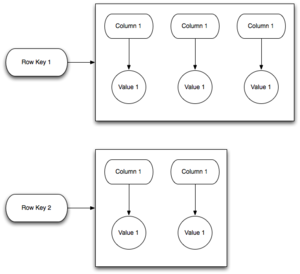DistOS-2011W Cassandra and Hamachi
In the beginning
The Internet has seen remarkable growth over the last few years, both technologically and socially. The demand for real-time information has increased at exponential rates and has put existing information systems to the test. For this paper I decided to look at two new software projects that have emerged over the last few years: Cassandra and Hamachi. Cassandra is a distributed database that evolved from the needs of websites such as Twitter and Facebook, whose need for frequent and short updates was too taxing on standard RDBMSs. Hamachi, which is in part a commercial project now, started as an open-source project aimed at creating zero-config VPNs. The project is now part of LogMeIn but is still free to use for non-commercial purposes.
In normal implementation circumstances you would not find these two projects paired together, but the concept of having a distributed database over a reasonably secure connection was one I thought was worth exploring. Over the course of this paper I'll discuss both projects in a reasonable amount of detail before detailing my implementation experiment and experience.
Cassandra
Cassandra is a distributed, decentralized, scalable and fault tolerant database system (or at least it claims to be) currently under development by the Apache foundation. It shares some features from both the Bigtable and Dynamo projects, but has more focus on decentralization. It sports a tuneable consistency and replication system which, together with a flexible schema system, can quickly adapt to a site or project's growing needs. Well, enough salesman talk, let's get to the details.
Over the course of this subsection I'll be covering some of the basic concepts of Cassandra and how they contribute to the "bigger picture", as well as some implementation and installation details.
The Data Model

Cassandra takes a different approach compared to RDBMSs when it comes to how data is conceptualized and managed. In a standard RDBMS, data is normalized into a series of tables with a set number of columns. For the most part, the types and number of these columns will only rarely change as the need arises. For a later analogy, we'll refer to this model as a "Narrow Row" model. Cassandra operates on a system of Column Families which are analogous to a tables in an RDBMS, but is much more flexible. Column Families (hereafter referred to as CFs) are a loose grouping of common data keyed by some value for each row in question. However, as opposed to the static feel of a RDBMS table, the number of columns or even the types of columns can and will change under Cassandra. That isn't to say there is no form of schema in Cassandra, because there is a simple type-enforcement schema system in place for each CF. To complete the analogy, the model for Cassandra can be seen as "Wide Row", with the number of columns growing however you please. Different rows in the same CF can even have a different number of columns.
The downside to such a data model is that Cassandra has no actual query language. There is no equivalent to SQL in Cassandra. There is also no support for referential integrity, either. With such circumstances maintaining data normalization while keeping processing time to a minimum is extremely difficult and is actively frowned upon. That's right, data duplication is encouraged when working with Cassandra. Luckily, the latest version (0.7.0 as of this writing) has introduced indexes to the meta-data that can be assigned to a column. This allows for basic boolean logic queries can be constructed to filter results better.
Systems/Programs in the Space
Give an overview of the area you are examining. What systems/programs are out there?
Evaluated Systems/Programs
Describe the systems individually here - their key properties, etc. Use subsections to describe different implementations if you wish. Briefly explain why you made the selections you did.
Experiences/Comparison (multiple sections)
In multiple sections, describe what you learned.
Discussion
What was interesting? What was surprising? Here you can go out on tangents relating to your work
Conclusion
Summarize the report, point to future work.
References
Give references in proper form (not just URLs if possible, give dates of access).